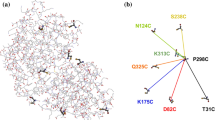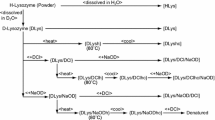Abstract
We describe methods that have been developed within the ILL-EMBL Deuteration Laboratory for the production of maltose binding protein (MBP) that has been selectively labelled either with deuterated tryptophan or deuterated methionine (single labelling), or both (double labelling). MBP is used as an important model system for biophysical studies, and selective labelling can be helpful in the analysis of small-angle neutron scattering (SANS) data, neutron reflection (NR) data, and high-resolution neutron diffraction data. The selective labelling was carried out in E. coli high-cell density cultures using auxotrophic mutants in minimal medium containing the required deuterated precursors. Five types of sample were prepared and studied: (1) unmodified hydrogenated MBP (H-MBP), (2) perdeuterated MBP (D-MBP), (3) singly labelled MBP with the tryptophan residues deuterated (D-trp MBP), (4) singly labelled MBP with methionine residues deuterated (D-met MBP) and (5) doubly labelled MBP with both tryptophan and methionine residues deuterated (D-trp/met MBP). Labelled samples were characterised by size exclusion chromatography, gel electrophoresis, light scattering and mass spectroscopy. Preliminary small-angle neutron scattering (SANS) experiments have also been carried out and show measurable differences between the SANS data recorded for the various labelled analogues. More detailed SANS experiments using these labelled MBP analogues are planned; the degree to which such data could enhance structure determination by SANS is discussed.





Similar content being viewed by others
References
Artero JB, Härtlein M, McSweeney S, Timmins P (2005) A comparison of refined X-ray structures of hydrogenated and perdeuterated rat gamma E-crystallin in H 2 O and D 2 O. Acta Cryst D 61:1541–1549
Ben-Bassat A, Bauer K, Chang SY, Myambo K, Boosman A, Chang S (1987) Processing of the initiation methionine from proteins: properties of the Escherichia coli methionine aminopeptidase and its gene structure. J Bacteriol 169(2):751–757
Bernado P, Mylonas E, Petoukhov MV, Blackledge M, Svergun DI (2007) Structural characterization of flexible proteins using small-angle X-ray scattering. J Am Chem Soc 129:5656–5664
Callow P, Sukhodub A, Taylor J, Kneale G (2007) Shape and subunit organisation of the DNA methyltransferase M. Ahdl. J Mol Biol 69(1):177–185
Capel MS, Engelman DM, Freeborn BR, Kjeldgaard M, Langer JA, Ramakrishnan V, Schindler DG, Schneider DK, Schoenborn BP, Sillers I-Y, Yabuki S, Moore PB (1987) A complete mapping of the proteins in the small ribosomal subunit of Escherichia coli. Science 238:1403–1406
Dottavio-Martin D, Ravel JM (1978) Radiolabelling of proteins by reductive alkylation with [14C]formaldehyde and sodium cyanoborohydride. Anal Biochem 87(2):562–565
Forsyth VT, Myles D, Timmins P, Hartlein M (2001) Possibilities for the exploitation of biological deuteration in neutron scattering. In: Dianoux J (ed) Opportunities for neutron scattering in the 3rd millennium. Institut Laue Langevin publication, Grenoble, pp 47–54
Fox JD, Waugh DS (2003) Maltose-binding protein as a solubility enhancer. Methods Mol Biol 205:99–117
Gardner KH, English AD, Forsyth VT (2004) New insights into the structure of poly (p-phenylene terephthalamide) from neutron fiber diffraction studies. Macromolecules 37(25):9654–9656
Gasteiger E, Hoogland C, Gattiker A, Duvaud S, Wilkins MR, Appel RD, Bairoch A (2005) Protein identification and analysis tools on the ExPASy server. In: Walker JM (ed) The proteomics protocols handbook. Humana Press, Louisville, pp 571–60
Grage SL, May RP, Holt SA, Moulin M, Haertlein M, de Planque M, Mendes GP, Contera SA, Turdzeladze T, Burck J, Martinac B, Forsyth VT, Watts A, Ulrich AS (2008) Opening of the mechanosenstitive channel protein studied by small-angle neutron scattering and neutron reflection (in preparation)
Haertlein M et al (2008) The ILL-EMBL Deuteration Laboratory: an advanced macromolecular labelling platform for neutron scattering and NMR (in preparation)
Hauptman HA, Langs DA (2003) The phase problem in neutron crystallography. Acta Cryst A 59:250–4
Hazemann I, Dauvergne M.T, Blakeley MP, Meilleur F, Haertlein M, Van Dorsselaer A, Mitschler A, MylesD, Podjarny A (2005) High-resolution neutron protein crystallography with radically small crystal volumes: application of perdeuteration to human aldose reductase. Acta Cryst D61:1413–1417
Huque ME, Vogel HJ (1993) Carbon-13 NMR studies of the lysine side chains of calmodulin and its proteolytic fragments. J Protein Chem 12(6):695–707
Jacrot B (1976) Study of biological structures by neutron scattering from solution. Rep Prog Phys 39(10):911–953
Kainosho M, Torizawa T, Iwashita Y, Terauchi T, Ono AM, Guntert P (2006) Optimal isotope labelling for NMR protein structure determinations. Nature 440:52–57
King WA, Stone DB, Timmins PA, Narayanan T, von Brasch AAM, Mendelson RA, Curmi PMG (2005) Solution structure of the chicken skeletal muscle troponin complex via small-angle neutron and X-ray scattering. J Mol Biol 345:797–815
Kuzmanovic DA, Elashvili I, Wick C, O’Connell C, Krueger S (2003) Bacteriophage MS2: molecular weight and spatial distribution of the protein and RNA components by small-angle neutron scattering and virus counting. Structure 11:1339–1348
Langan P, Nishiyama Y, Chanzy H (1999) A revised structure and hydrogen bonding system in cellulose II from a Neutron fiber diffraction analysis. J Am Chem Soc 121:9940–9946
Liu X, Hanson BL, Langan P, Viola RE (2007) The effect of deuteration on protein structure: a high-resolution comparison of hydrogenous and perdeuterated haloalkane dehalogenase. Acta Cryst D63(9):1000–1008
Lu JR, Thomas RK, Penfold J (2000) Surfactant layers at the air/water interface: structure and composition. Adv Colloid Interf Sci 84(1–3):143–304
Maina CV, Riggs PD, Grandea AG, Slatko BE, Moran LS, Tagliamonte JA, McReynolds A, Guan CD (1988) An Escherichia coli vector to express and purify foreign proteins by fusion to and separation from maltose-binding protein. Gene 71:5–373
May RP, Nowotny V, Nowotny P, Voss H, Nierhaus KH (1991) Inter-protein distances within the large subunit from Escherichia coli ribosomes. EMBO J 11:373–378
Nishiyama Y, Chanzy H, Langan P (2002) Crystal structure and hydrogen bonding system in cellulose Iβ from synchrotron X-ray and neutron fiber diffraction. J Am Chem Soc 124:9074–9082
Nishiyama Y, Sugiyama J, Chanzy H, Langan P (2003) Crystal structure and hydrogen bonding system in cellulose Iα from synchrotron X-ray and neutron fiber diffraction. J Am Chem Soc 125:14300–14306
Paciaroni A, Orecchini A, Cornicchi E, Marconi M, Petrillo C, Sacchetti F, Haertlein M, Moulin M, Tarek M (2008) Low-frequency vibrational dynamicsof protein hydration water; comparison with hexagonal and amporphous ices (submitted)
Pardon JF, Worcester DL, Wooley JC, Cotter RI, Lilley DMJ, Richards BM (1977) The structure of the chromatin core particle in solution. Nucl Acids Res 4(9):3199–3214
Parrot I, Haertlein M, Forsyth VT (2008) Enzymatic synthesis of selectively labelled repetitive sequence DNA (in preparation)
Pebay-Peyroula E, Garavito RM, Rosenbusch JP, Zulauf M, Timmins PA (1995) Detergent structure in tetragonal crystals of Ompf porin. Structure 3:1051–1059
Petoukhov MV, Eady NAJ, Brown KA, Svergun DI (2002) Addition of missing loops and domains to protein models using X-ray solution scattering. Biophys J 83:3113–3125
Petoukhov MV, Monie TP, Allain F-T, Matthews S, Curry S, Svergun DI (2006) Conformation of polypyrimidine tract binding protein in solution. Structure 14:1021–1027
Petoukhov MV, Svergun DI (2005) Global rigid body modeling of macromolecular complexes against small-angle scattering data. Biophys J 89:1237–1250
Petoukhov MV, Svergun DI (2006) Joint use of small-angle X-ray and neutron scattering to study biological macromolecules in solution. Eur Biophys J 35:567–576
Ramakrishnan V, Finch JT, Graziano V, Lee PL, Sweet RM (1993) Crystal structure of globular domain of histone H5 and its implications for nucleosome binding. Nature 362(6417):219–223
Ramesh V, Frederick RO, Syed SEH, Gibson CF, Yang J-C, Roberts GCK (1994) The interactions of Escherichia coli trp repressor with tryptophan and with an operator oligonucleotide. Eur J Biochem 225:601–608
Réat V, Patzelt H, Pfister C, Ferrand M, Oesterhelt D, Zaccai G (1998) Dynamics of different functional parts of bacteriorhodopsin: H–2H labelling and neutron scattering. Proc Natl Acad Sci (USA) 95:4970–4975
Schwartz MO, Kellermann O, Szmelcman S, Hazelbauer GL (1976) Further studies on the binding of maltose to the maltose binding protein of Escherichia coli. Eur J Biochem 71:167–170
Sharff AJ, Rodseth LE, Spurlino JC, Quiocho FA (1992) Crystallographic evidence of a large ligand-induced hinge-twist motion between the two domains of the maltodextrin binding protein involved in active transport and chemotaxis. Biochemistry 31:10657–10663
Shilton BH, Shuman HA, Mowbray SL (1996a) Crystal structures and solution conformations of a dominant-negative mutant of Escherichia coli maltose-binding protein. J Mol Biol 264:364–376
Shilton BH, Flocco MM, Nilson M, Mowbray SL (1996b) Conformational changes of three periplasmic receptors for bacterial chemotaxis and transport: the maltose-, glucose/galactose- and ribose-binding proteins. J Mol Biol 264:350–363
Spurlino JC, Lu G-Y, Quiocho FA (1991) The 2.3-A resolution structure of the maltose- or maltodextrin-binding protein, a primary receptor of bacterial active transport and chemotaxis. J Biol Chem 266:5202–5219
Sreenath HK, Bingman CA, Buchan BW, Seder KD, Burns BT, Geetha HV, Jeon WB, Vojtik FC, Aceti DJ, Frederick RO, Phillips GN, Fox BG (2005) Protocols for production of selenomethionine-labelled proteins in 2-L polyethylene terephthalate bottles using auto-induction medium. Protein Expr Purif 40(2):256–267
Stuhrman HB (1974) Neutron small-angle scattering of biological macromolecules in solution. J Appl Cryst 7:173–178
Svergun DI, Richard S, Koch MHJ, Sayers Z, Kuprin S, Zaccai G (1998) Protein hydration in solution: experimental observation by X-ray and neutron scattering. Proc Natl Acad Sci USA 95(5):2267
Svergun DI (1999) Restoring low resolution structure of biological macromolecules from solution scattering using simulated annealing. Biophys J 76(6):2879–2886
Svergun DI, Petoukhov MV, Koch MHJ (2001) Determination of domain structure of proteins from X-ray solution scattering. Biophys J 80:2946–2953
Svergun DI, Koch M, Konarev P, Timmins PA, Volkov V, Zaccai G (2000) A contrast variation study of the tertiary structure of selectively deuterated proteins, Beamtime application at Institut Laue Langevin, reference number 8-03-368
Tehei M, Franzetti B, Wood K, Gabel F, Fabiani E, Jasnin M, Zamponi M, Oesterhelt D, Zaccai G, Ginzburg M, Ginzburg BZ (2007) Neutron scattering reveals extremely slow cell water in a Dead Sea organism. Proc Natl Acad Sci USA 104:766–771
Timmins PA, Zaccai G (1988) Low resolution structures of biological complexes studied by neutron scattering. Eur Biop J Bioph Lett 15(5):257–268
Varga K, Azlimikova L, Parrot I, Dauvergne M-Th, Haertelin M, Forsyth VT, Watts A (2007) NMR crystallography: the effect of deuteration on high resolution 13C solid state NMR spectra of a 7-TM protein. Biochim Biophys Acta 1768:3029–3035
Wada M, Chanzy H, Nishiyama Y, Langan P (2004) Cellulose IIII crystal structure and hydrogen bonding by synchrotron X-ray and neutron fiber diffraction. Macromolecules 37(23):8548–8555
Walter TS, Meier C, Assenberg R, Au KF, Ren J, Verma A, Nettleship JE, Owens RJ, Stuart DI, Grimes JM (2006) Lysine methylation as a routine rescue strategy for protein crystallization. Structure 14(11):1617–1622
Waugh DS (1996) Genetic tools for selective labeling of proteins with α-15N amino acids. J Biomol NMR 8:184–192
Wood K, Frolich A, Paciaroni, Moulin M, Hartlein M, Zaccai G, Tobias D, Weik M (2008) Coincidence of hydration-water and soluble-protein dynamical transitions: direct measurements by neutron scattering and MD simulations (submitted)
Zheng W, Doniach S (2002) Protein structure prediction constrained by solution X-ray scattering data and structural homology identification. J Mol Biol 316:173–187
Zukin RS (1979) Evidence for a conformational change in Escherichia coli maltose receptor by excited-state fluorescence lifetime data. Biochemistry 18:2139–2145
Acknowledgments
This work was supported by the European Union under contract RII3-CT-2003-505925. It has also benefited from previous development work carried out under HPRI-2001-50065. We acknowledge the EPSRC for support under grants EP/C015452/1 and GR/R47950/01 and the Institut de Biologie Structurale in Grenoble for the use of their mass spectroscopy service. The authors are also very grateful for advice and assistance from all members of the ILL-EMBL Deuteration Laboratory, in particular Martine Moulin.
Author information
Authors and Affiliations
Corresponding author
Rights and permissions
About this article
Cite this article
Laux, V., Callow, P., Svergun, D.I. et al. Selective deuteration of tryptophan and methionine residues in maltose binding protein: a model system for neutron scattering. Eur Biophys J 37, 815–822 (2008). https://doi.org/10.1007/s00249-008-0280-5
Received:
Revised:
Accepted:
Published:
Issue Date:
DOI: https://doi.org/10.1007/s00249-008-0280-5




